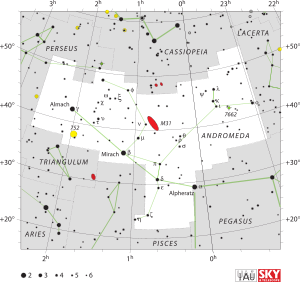Psi Andromedae
 | |
| Observation data Epoch J2000 Equinox J2000 | |
|---|---|
| Constellation | Andromeda |
| Right ascension | 23h 46m 02.04663s[1] |
| Declination | +46° 25′ 12.9788″[1] |
| Apparent magnitude (V) | 4.95[2] |
| Characteristics | |
| Spectral type | G5 Ib[3] + B9[4] |
| U−B color index | +0.83[2] |
| B−V color index | +1.085[3] |
| Astrometry | |
| Radial velocity (Rv) | -23.62[3] km/s |
| Proper motion (μ) | RA: +9.07[1] mas/yr Dec.: -7.83[1] mas/yr |
| Parallax (π) | 3.25 ± 0.47[1] mas |
| Distance | approx. 1,000 ly (approx. 310 pc) |
| Absolute magnitude (MV) | –3.039[3] |
| Details | |
| ψ And A | |
| Mass | 5.4[4] M☉ |
| Surface gravity (log g) | 1.50[3] cgs |
| Temperature | 4,990[3] K |
| Metallicity [Fe/H] | +0.10[3] dex |
| Age | 79[4] Myr |
| Other designations | |
| Database references | |
| SIMBAD | data |
Psi Andromedae (ψ And, ψ Andromedae) is the Bayer designation for a triple star[4] system in the northern constellation of Andromeda. The combined apparent visual magnitude of this system is 4.95.[2] Based upon parallax measurements, is roughly 1,000 light-years (310 parsecs) from Earth, with 14% margin of error.[1]
The primary component has a stellar classification of G5 Ib,[3] which matches the spectrum of an evolved bright giant star. It forms a pair with a star of type B9 with an unknown luminosity class separated by 0.28 arcseconds. A third component has a separation of 0.14 arcseconds. Details of the orbital arrangement remain uncertain.[4]
Naming
In Chinese, 螣蛇 (Téng Shé), meaning Flying Serpent, refers to an asterism consisting of ψ Andromedae, α Lacertae, 4 Lacertae, π2 Cygni, π1 Cygni, HD 206267, ε Cephei, β Lacertae, σ Cassiopeiae, ρ Cassiopeiae, τ Cassiopeiae, AR Cassiopeiae, 9 Lacertae, 3 Andromedae, 7 Andromedae, 8 Andromedae, λ Andromedae, κ Andromedae and ι Andromedae,. Consequently, ψ Andromedae itself is known as 螣蛇二十 (Téng Shé èrshí, English: the Twentieth of Flying Serpent).[6]
References
- 1 2 3 4 5 6 van Leeuwen, F. (November 2007), "Validation of the new Hipparcos reduction", Astronomy and Astrophysics, 474 (2): 653–664, arXiv:0708.1752, Bibcode:2007A&A...474..653V, doi:10.1051/0004-6361:20078357.
- 1 2 3 Argue, A. N. (1966), "UBV photometry of 550 F, G and K type stars", Monthly Notices of the Royal Astronomical Society, 133: 475–493, Bibcode:1966MNRAS.133..475A, doi:10.1093/mnras/133.4.475.
- 1 2 3 4 5 6 7 8 Soubiran, C.; et al. (March 2008), "Vertical distribution of Galactic disk stars. IV. AMR and AVR from clump giants", Astronomy and Astrophysics, 480 (1): 91–101, arXiv:0712.1370, Bibcode:2008A&A...480...91S, doi:10.1051/0004-6361:20078788.
- 1 2 3 4 5 Parsons, Sidney B. (May 2004), "New and Confirmed Triple Systems with Luminous Cool Primaries and Hot Companions", The Astronomical Journal, 127 (5): 2915–2930, Bibcode:2004AJ....127.2915P, doi:10.1086/383546.
- ↑ "* psi And". SIMBAD. Centre de données astronomiques de Strasbourg. Retrieved 28 January 2018.
- ↑ (in Chinese) AEEA (Activities of Exhibition and Education in Astronomy) 天文教育資訊網 2006 年 7 月 7 日